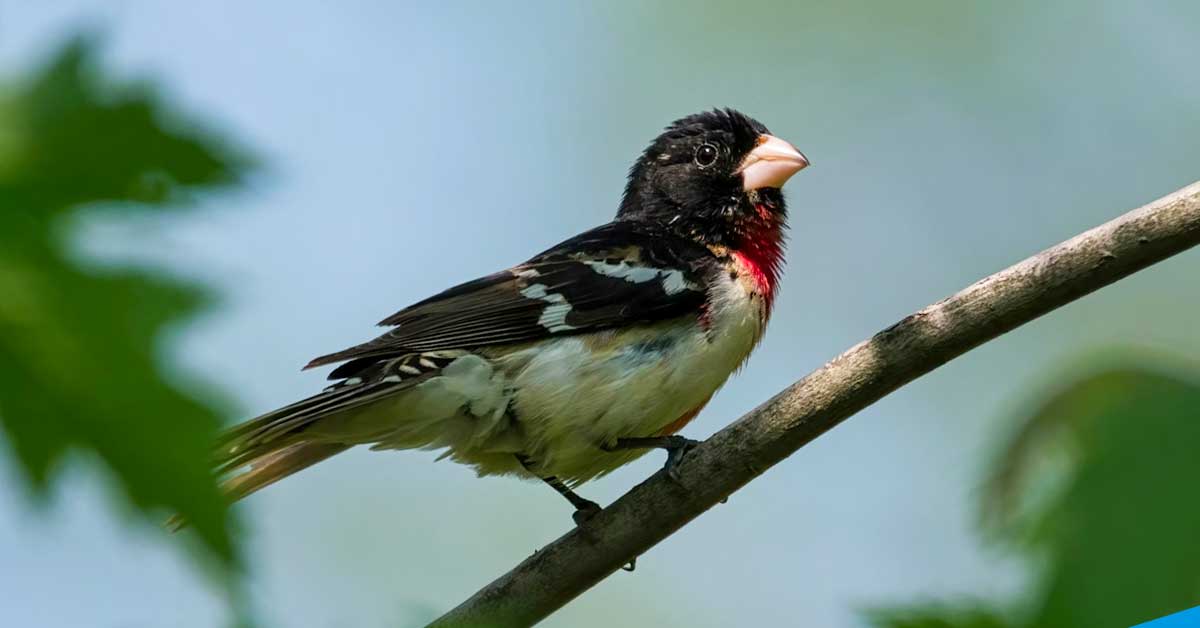Iowa has over 400+ bird species found in rural and urban areas of the state. While some of them migrate to other parts of the country, many of these Iowa birds stick around the entire year.
Iowa’s birds fall under several categories, including backyard birds (those you find in your backyards), migratory birds (those found in Iowa only during the summer or winter), water birds, or even Birds of Prey.
12 Gorgeous Birds of Iowa
Here are 12 of my favorite cool-looking birds of Iowa:
1. Red-Winged Blackbird (Agelaius phoeniceus)
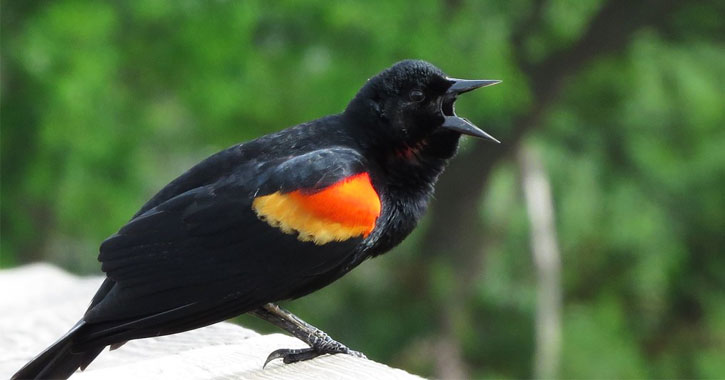
- Length: 9 to 10 inches
- Weight: 2.5 to 3 ounces
- Wingspan: 12 to 16 inches
The Red-winged Blackbird looks exotic, but they’re actually pretty common in Iowa. If you’re a local, there’s a good chance you’ve seen these black birds before.
They live in areas near marshes, fields, meadows and saltwater. Within cities, these birds often visit gold courses.
Red-winged Blackbird looks exactly how it’s named – their entire body is covered in black feathers except for the vibrant red orange patch on their wings. Even if you’re new to birding, this bird’s striking black-and-orange contrast makes it easy to identify.
Ironically, even if it’s hard to miss these red-winged blackbirds, they will do anything for attention. These birds love perching on high trees, singing loudly for all the world to see and hear.
Red-winged Blackbird feed on grasshoppers, caterpillars, beetles, spiders, snails and other insects. They also eat seeds, weeds, grasses, grains, and small fruits like berries.
2. Northern Cardinal (Cardinalis cardinalis)

- Length: 7 to 9 inches
- Weight: 1 to 3 ounces
- Wingspan: 10 to 12 inches
Northern Cardinals are one of the most common birds in Iowa. They’re also pretty popular with the locals, mostly for their striking good looks.
Northern Cardinals are found in a wide range of Iowa habitats, from woodlands to swamps, parks to backyards, and even in dense forests.
Both male and female Northern Cardinals have spikey “hair”, a crest on their heads, and a short thick bill.
- Male Northern Cardinal appearance: The males are bright-red all over with a black face and throat, then red bill.
- Female Northern Cardinal appearance: Females are pale yellow and brown overall with red-tinged stripes on their crests, wings, and tails. Like their male counterparts, these female birds also have black face and red-orange bill.
Northern Cardinals have a feisty personality and can be territorial, especially during breeding season. Both males and females sing, which is rare for birds (since males are usually the ones singing to woo their females).
These birds feed on seeds, weeds, flowers, berries and other wild fruits, snails, spiders, caterpillars, beetles, and other insects.
3. Cedar Waxwing (Bombycilla cedrorum)

- Length: 6 to 8 inches
- Weight: About 1 ounce
- Wingspan: 12 inches
Cedar Waxwings are frequently spotted in Iowa year-round, but they go out near humans to find berries in the summer and fall months.
The habitat of these birds depend largely on the availability of fruiting trees or shrubs, so you can find them in fields, berry bushes, residential yards, forest edges, streams and other similar areas.
Male and female Cedar Waxwings look very similar, except for the male’s chin which is darker than the females. Both have pale yellow bellies, bright-yellow tails, red-dipped wingtips, a pale brown patch on the head, a narrow mask over their eyes, and brown chest and crest.
Cedar Waxwings are social birds and are often seen hanging out with other waxwings drinking sap or eating berries and other small fruits.
4. Pine Siskin (Spinus pinus)
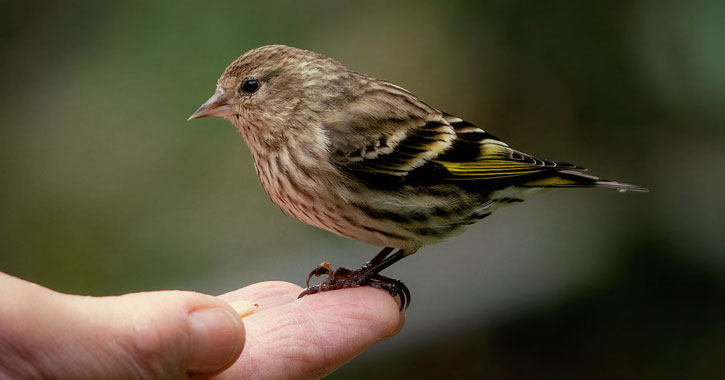
- Length: 4 to 6 inches
- Weight: Around 0.5 ounces
- Wingspan: 7 to 9 inches
Pine Siskins are one of the most common finches in Iowa. However, many researchers suggest that these birds’ population has decreased in a massive 80% since the 1970s.
Today, Pine Siskins can be found in mixed and coniferous woods.
Pine Siskins are the only birds in the finch family that look exactly the same between sexes. At closer look, you’ll see minor differences in the amount of streaks, but they’re barely noticeable.
Male and female Pine Siskins are small and overall brown in color with light yellow streaks distributed along their chests, wings, and fork-like tails. They also have long pointed wingtips and small, but super-pointed bill.
Pine Siskins are social birds; they are rarely seen alone. They hunt for food (weeds, grass, birch seeds, and some insects) in flocks and often noisily chirping to each other.
5. American Goldfinch (Spinus tristis)
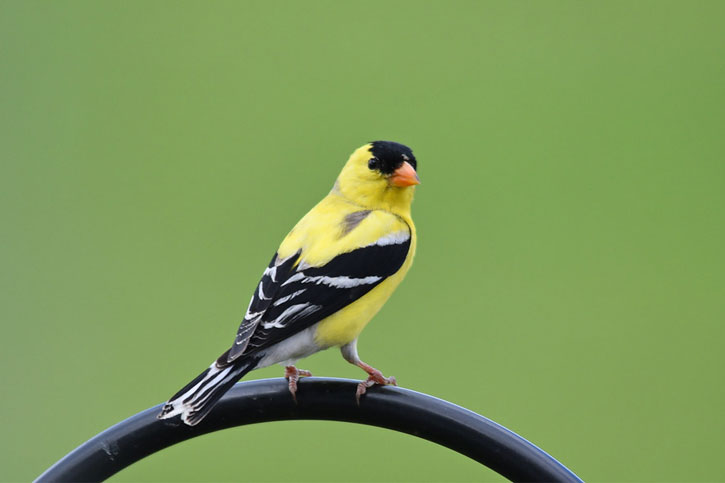
- Length: 4 to 5 inches
- Weight: About 0.5 ounces
- Wingspan: 7 to 9 inches
American Goldfinch is the State Bird of Iowa (made official in May 1933) and remains a common bird around the state. They’re considered backyard birds, but also stay in woodland edges, open fields, orchards, and parks.
- Male American Goldfinch appearance: Adult males are bright yellow from their underbellies to their backs. They also have a contrasting all-black forehead and black wings with white wingbars. Males have orange cone-shaped bills.
- Female American Goldfinch appearance: Adult females look very similar to their male counterparts, except their yellow color is a lot duller. Even their bills are olive-colored.
American Goldfinches are rays of sunshine – they are cheerful, social and hyperactive. These gorgeous yellow birds primarily eat daisy seeds, but also eat weeds, grasses, and seeds of elm, alder, and birch trees.
6. Dickcissel (Spiza americana)
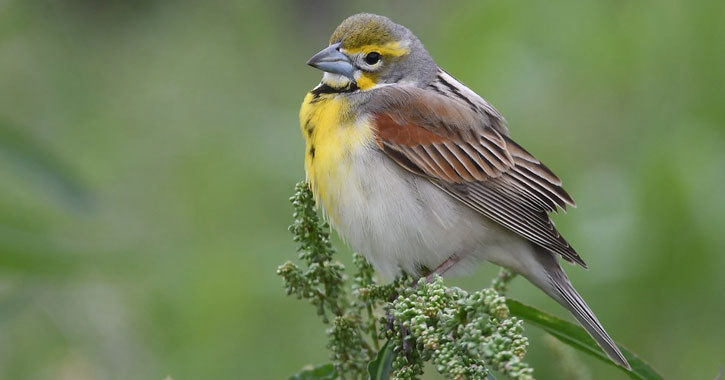
- Length: 5 to 6.5 inches
- Weight: 0.9 to 1.5 ounces
- Wingspan: 9 to 10.5 inches
Dickcissels are common songbirds in Iowa, but because they look very similar to many bird species, they actually are pretty hard to identify.
These birds need to live in grassland year-round, but Dickcissels are very adaptable and have been seen to thrive in native prairies, hayfields, fields, grazed pastures, and even roadsides.
- Male Dickcissels appearance: Adult males have a gray patch on the head, yellow face, and yellow chest crossed with a contrasting black-colored V. Males have a brown and gray back with reddish brown shoulders.
- Female Dickcissels appearance: Females have hints of yellow on their eyebrows and chests, but with tamed brown on the shoulders and no V-shape marking on the chest.
Dickcissels are solitary during breeding season, but get back to their super-sociable selves the rest of the year and join massive flocks of wintering birds.
As for their diets, Dickcissels feed on seeds and small insects such as flies, beetles, spiders, grasshoppers, wasps, and so on.
7. Western Meadowlark (Sturnella neglecta)
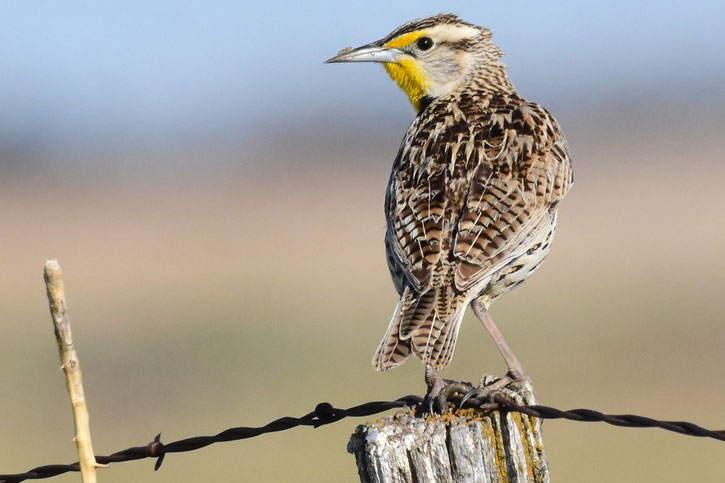
- Length: 8 to 9 inches
- Weight: 3 to 4 ounces
- Wingspan: About 16 inches
The number of Western Meadowlarks in Iowa is considered cyclical (rises and falls), but despite declining in population, these birds are still common and widespread.
As grassland birds, Western Meadowlarks live in open spaces like agricultural fields, but can also adapt to mountain meadows, marsh edges and weedy parts of the roads.
Male and female Western Meadowlarks look exactly the same, but the female colors are usually less brighter than their male counterparts.
Both sexes are robin-sized with a flat head and long but thin bill. Their upperparts are predominantly brown with black barring all over. Their underparts are bright yellow with a contrasting black “V” mark. The shoulders wings of Western Meadowlarks are rounded with short and spiky tails.
Meadowlarks in general are known for their friendly and gentle behavior, but they can become aggressive during breeding season. These birds eat many kinds of insects, but they love seeds and waste grain as well.
8. Purple Finch (Haemorhous purpureus)

- Length: About 5.5 inches
- Weight: 0.5 to 1.1 ounces
- Wingspan: 9 to 10 inches
Purple Finches are a common bird found year-round all over Northern Iowa. They inhabit both urban and forested areas, breading in mixed (wet or cool) forests, orchards, pastures, or even backyards.
These large and chubby forest birds have a pretty pinkish red feathers on their heads and breast with browns all over their backs and fluffy white on their bellies. Female Purple Finches look the same as the males, except for lack of red hues on their plumage.
Purple Finches have an angry look thanks to their strong facial markings and dark line by the throats.
Like many birds with strong beaks, the Purple Finch uses its cone-shaped beaks to crush the seeds of fruits and trees. They also feed on small insects and weeds.
Although these birds look feminine with their colors, Purple Finches are actually quite aggressive when they feel attacked by other birds.
9. Brown Creeper (Certhia americana)
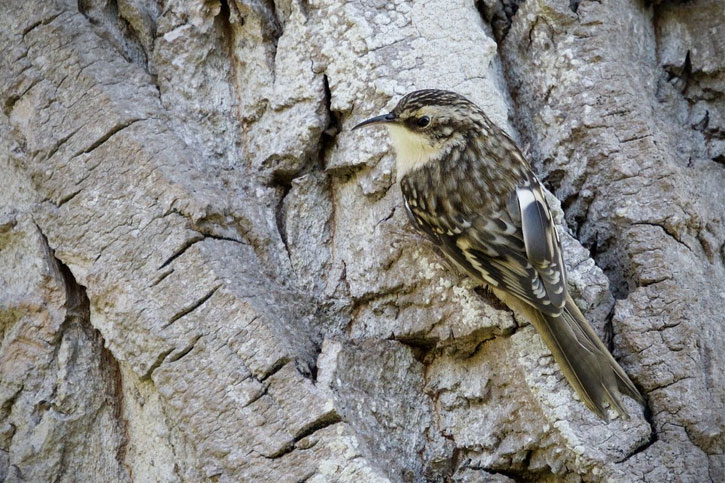
- Length: 4.7 to 5.5 inches
- Weight: 0.2 to 0.4 ounces
- Wingspan: 6.7 to 7.9 inches
Brown Creepers are common spring birds in Iowa’s north woods. They prefer conifer forests, woodlands, groves, and shaded trees. You can also see migrating Brown Creepers in city parks or areas with dense trees.
Male and female Brown Creepers look very similar, except males are a bit larger and have longer bills. Thanks to their buff and brown streaks from the head to their wings, these birds can easily camouflage against tree barks.
The rest of their features include white underparts that extend up to the bottom of their beaks.
It is easier to spot Brown Creepers because they are active during the day. However, they can be shy and solitary.
Brown Creepers prefer eating insects, but they sometimes feed on sunflower seeds, corn, and pine seeds.
10. Red-shouldered Hawk (Buteo lineatus)
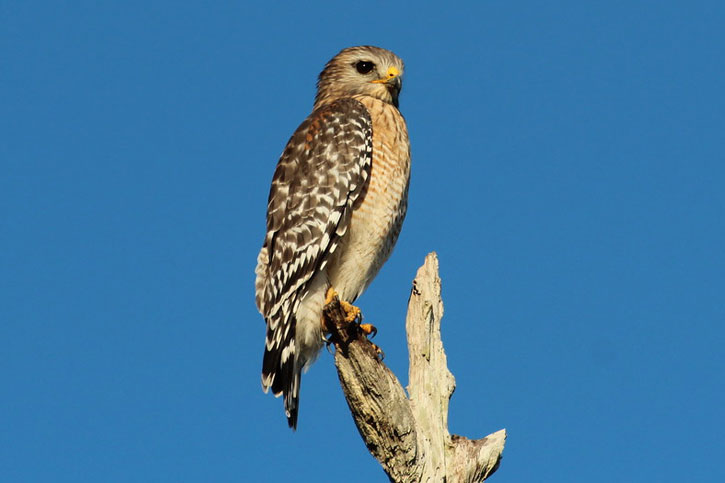
- Length: 16 to 24 inches
- Weight: 17 to 27 ounces
- Wingspan: 37 to 44 inches
Red-shouldered hawks are threatened bird species in Iowa. They are uncommon, but they stay year-round in mature woodlands, bottomland forests, deciduous swamps and even suburban areas with dense trees.
The best places in Iowa to find these gorgeous creatures is at the following:
- Saylorville Reservoir
- Ada Hayden Heritage Park
- Great River Birding Trail
- Hawkeye Wildlife Management Area
- Yellow River State Forest
Male and female Red-shouldered hawks have the same-colored feathers. The only difference is that females are noticeably larger than males.
Red-shouldered hawks have reddish brown plumage with checkered brown-and-white upperparts, as well as white-and-black banded tails and wings.
The diet of Red-shouldered hawks consist of small mammals, reptiles, amphibians, and smaller birds like doves, sparrows and starlings.
11. Rose-breasted Grosbeaks (Pheucticus ludovicianus)
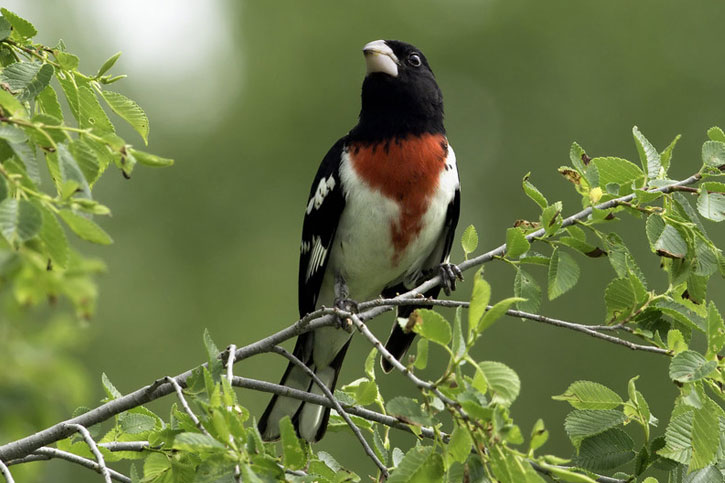
- Length: 7 to 8.5 inches
- Weight: 1.4 to 2 ounces
- Wingspan: 11 to 13 inches
Rose-breasted Grosbeaks spend summer in Iowa, so they’re spotted around April through October mostly in open deciduous woods and sometimes in overgrown fields, shrubby roads, old pastures, or even residential areas and city parks.
Male and female Rose-breasted Grosbeaks both have triangle-shaped bills and dramatic plumage, but in different ways.
- Male Rose-breasted Grosbeak appearance: The males have completely black heads with black wings dotted with white streaks, white bellies, and a vividly red breast. They also have a flash of red under their wings, which you can see when they’re in flight.
- Female Rose-breasted Grosbeak appearance: Females are brown-colored with a lot of streaking from the forehead down to the tails. When they spread their wings, you’ll see a flash of yellow under their wings.
Rose-breasted Grosbeaks are known for their angelic songs, but their songs are often mistaken for American Robins’ songs.
Rose-breasted Grosbeaks feed on smaller birds, lizards, snakes, crawfish, and other small mammals and amphibians.
12. Blue Jay (Cyanocitta cristata)
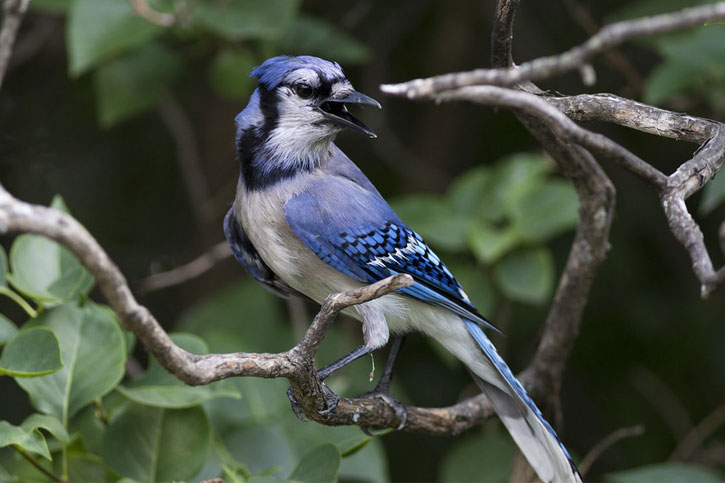
- Length: 9 to 12 inches
- Weight: 2.5 to 3.5 ounces
- Wingspan: 13 to 17 inches
Blue Jays are one of the most common birds of Iowa – they’re year-round residents and visit backyards often. These birds are one of the easiest to identify as well, thanks to their distinct purplish blue color.
Male and female Blue Jays look the same cool blue plumage, but males are often larger than females.
Blue Jays LOVE acorns. They also eat bugs, frogs, berries, nuts, and seeds.
Other Birds of Iowa & Birding Across USA
The birds above are just 12 from the numerous bird species found in Iowa.
If you’re ticking off your birding bucketlist and want to visit other states, check out my guides on the following birding destinations:
- Owls in Illinois
- Woodpeckers in Virginia
- Native Birds of Kauai, Hawaii
- Owls You Can Find in Kentucky
- Winter Birds of West Virginia
- Cute Woodpeckers You Can Find in Alaska
- Yosemite Birdwatching (if you’re visiting California’s awesome Yosemite Park)
- Different Types of Owls You Can Find in Utah
- Song Birds of Pennsylvania
